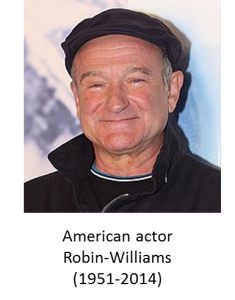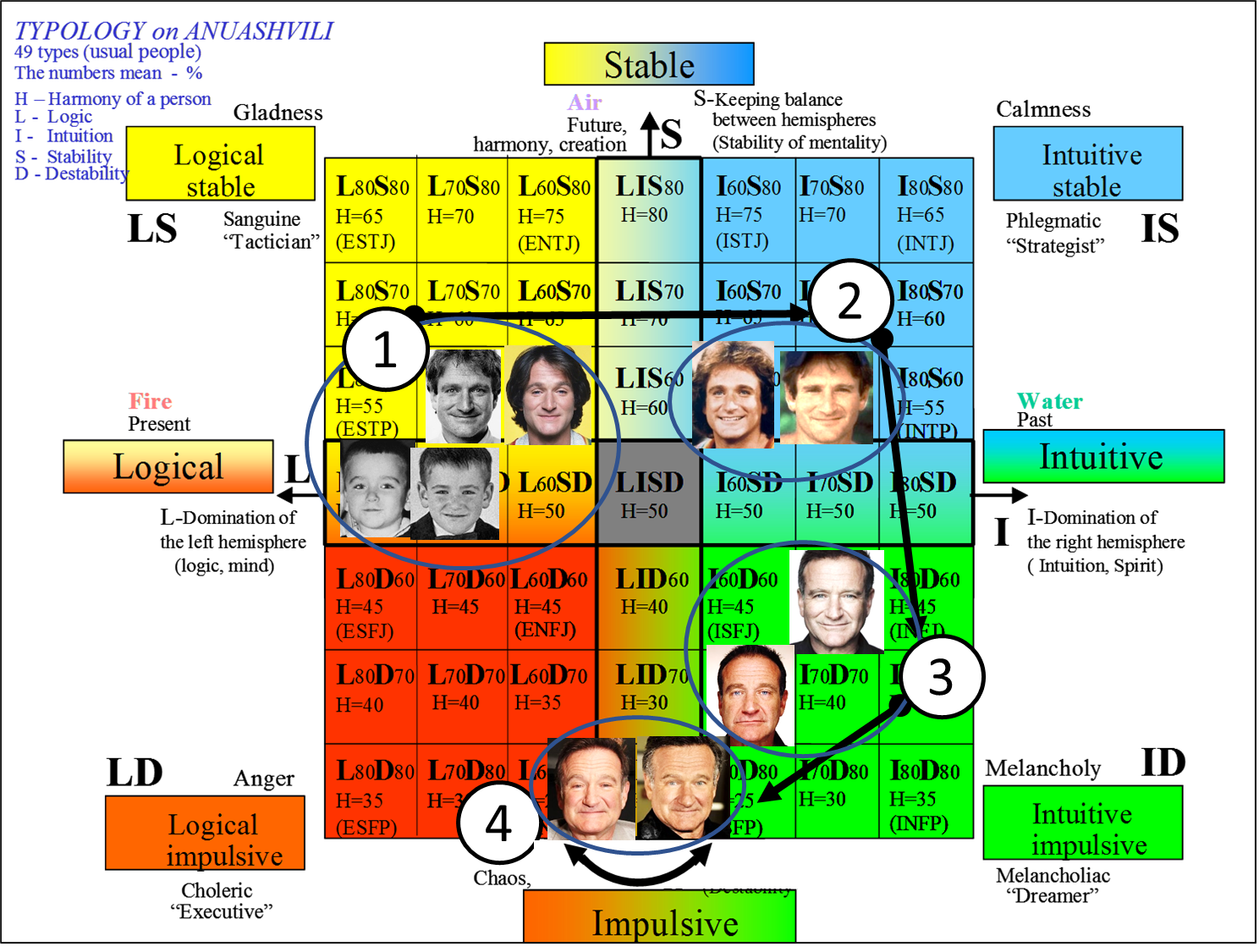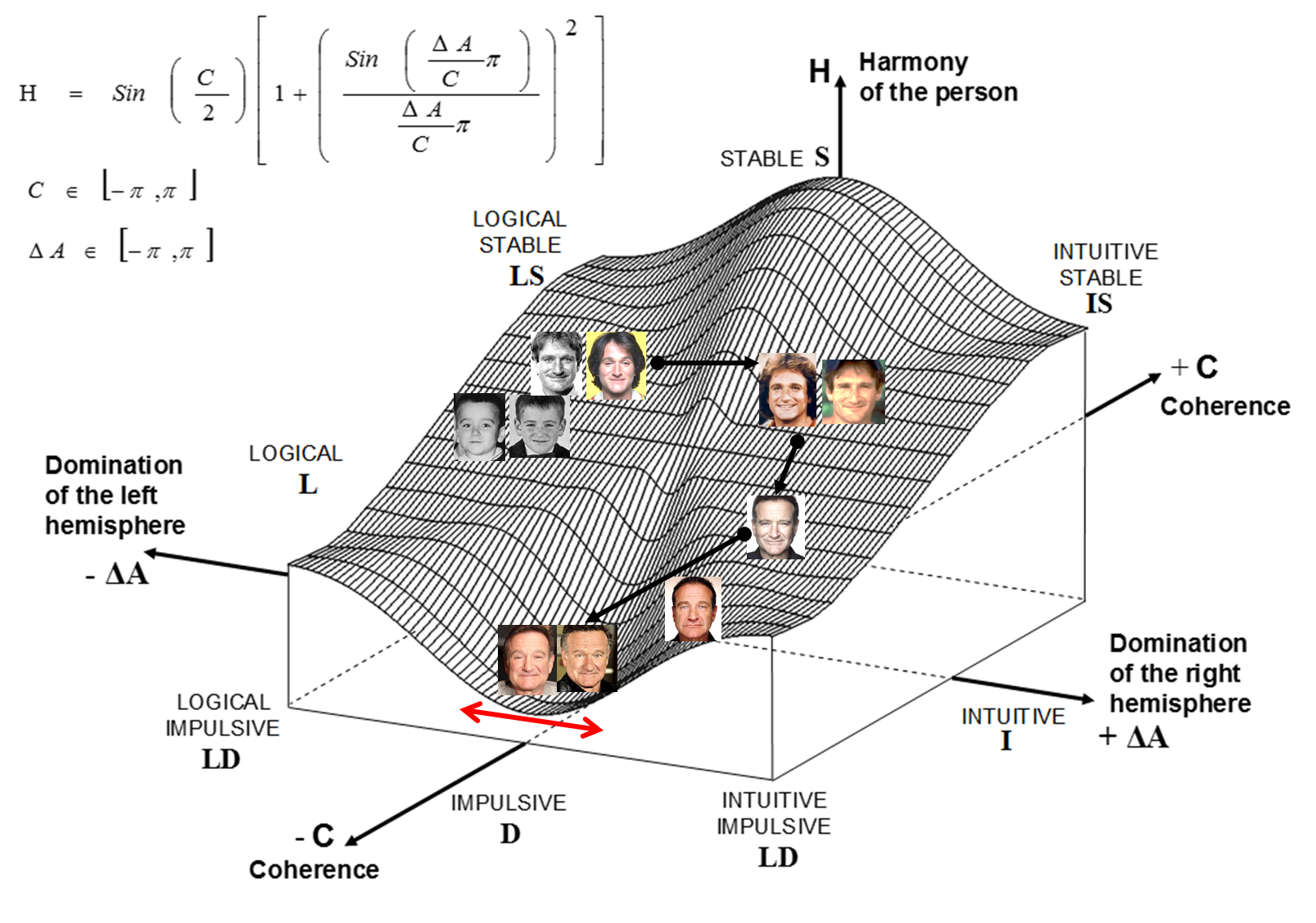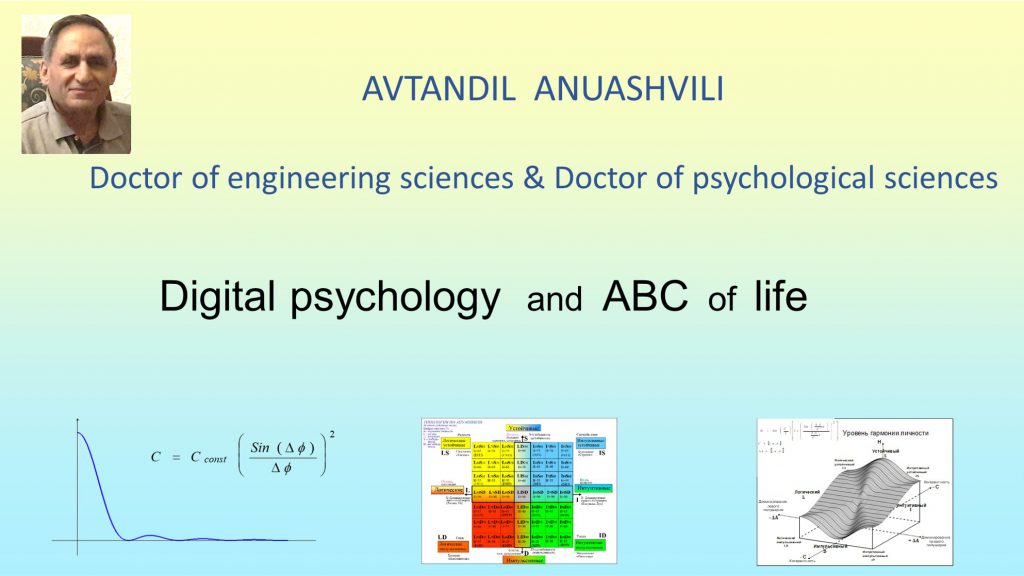English version
PSYCHOLOGICAL CONDITION DETERMINATION and CORRECTION METHOD based on WAVE MODEL of BRAIN
The essence of this method
This method is based on measurement of two parameters of brain:
- functional asymmetry of cerebral hemispheres,
- coherence of electromagnetic oscillations between the hemispheres.
The values of these two parameters determine the psychological type of a person and give out his personal characteristics, as well as recommendations for harmonizing his personality and relationships with other psychological types.
A regular relationship has been established between the indicated parameters of the brain and the phase portrait of the face (facial asymmetry and asymmetry of emotions on right and left sides of the face). This allows you to determine the indicated parameters of brain through the phase portrait of face, which simplifies the process of diagnosing psychological state of a person, having only his photograph.
The possibility of correcting the psychophysical state of a person by introducing a biological feedback of a person with visual images of his face and auditory images corresponding to his psychological type has been established. As a result of such correction, a person becomes more adequate and perceives the world around him more realistically.
This method allows you to explore a person in the past from his early photographs and determine the dynamics of changes in his psychological state.
Below is an example of determining the dynamics of the change in the psychological state of famous American actor Robin Williams from his early photographs, which made it possible to determine the underlying cause of his suicide.

On August 11, 2014, Williams committed suicide by hanging at his home in Paradise Cay, California. Medical experts struggled to determine a cause, and eventually diagnosed him with Parkinson’s disease. The report confirms he experienced depression, and anxiety, which may occur in either Parkinson’s disease or dementia with Lewy bodies.
Thus, somatic diseases were recognized as the cause of mental deviation (depression). And, it could be the other way around: The reason could be psychological, and everything else is a consequence. Video computer analysis of Williams photos shows that 4 periods stand out in his life (see diagram below):

- In childhood and adolescence he was active, cheerful and often was in a state of wild joy. During this period, the computer defines its psychological state as “Logical Stable”.
- At the second stage, during his youth, he is in an “Intuitive steady” state. This means that he was calm and confident. His condition is defined as calm and quiet joy. Such a psychological type is prone to realistic creativity. That is, if he becomes a playwright, writer, composer, director … he will feel psychologically comfortable and will not get tired. The computer does not recommend to become an actor, an athlete and groan on stage, in the arena in front of the audience. Not because he does not have enough abilities, but because he will experience psychological discomfort and will tire. It is precisely this mistake he makes. He goes on stage, acts in films, performs well, but gets tired, as he is an individual and will constantly feel his own emotions. Therefore, the simultaneous image of other people’s emotions (his hero) causes him internal tension.
- In the third stage, he is already a tired person. He has increased impulsiveness. He impulsively reacts to his internal stimuli and dramatizes the situation. He transitioned to Intuitive Impulsive. Such people are prone to depression, but can well control themselves. In this state, fantasy works well for a person and the computer recommends doing irrational art — becoming an abstract artist, designer, fashion designer, writing stories for children, costing beautiful buildings … but categorically does not recommend going on stage. But Williams makes a fatal mistake in life and continues to play roles, as a result of which he falls into chaos.
- In the fourth stage of his life, Williams finally gets tired. He is in an “Impulsive” state and is experiencing chaos — his mood changes impulsively from excited to depressed and vice versa. In this state, a person usually has suicidal thoughts.
Provided that this situation is correctly understood, such a person can undergo psychocorrection and return him to the best of previous conditions. But he remains in a chaotic state for a long time and he has somatic diseases. The causes of suicide is psychological. More precisely, not taking into account his psychological type and the lack of adequate psychological assistance.

The three-dimensional diagram of psychological types shows that Williams at the end of his life is in the deepened part of the diagram (the “pit”) and swings according to the law of the pendulum — he often has an unmotivated change of mood and, as a result, a tendency to suicidal thoughts.










The approximate list of characteristics and recommendations as a result of video-computer diagnostics of a psychophysical condition by means of the declared method
As a result of diagnostics of a psychophysical condition of the person the computer program gives out psychological characteristics, probabilities of occurrence of psychosomatic frustration and recommendations for change of way of life and a views, and also for harmonisation of the person and mutual relations.
The list of the characteristics which are given out by computer program as a result of diagnostics of psychosomatic condition of investigated person:
1. The psychological characteristic
1.1. Psychotype on Anuashvili on the basis of domination of one of hemispheres and coherency (coordination) between hemispheres, comparison with other typology — psychotype on Hippocrates- Galen and on Myers-Briggs, diagnostics according to ancient knowledge, recommendations on harmonization of the person and mutual relations and on change of a way of life and a way of thoughts.
1.2. Perception of time. Structure of perception of time and a percentage interrelation: past, future, present, past for the past, past for the future, present for the present, present for the future.
1.3. Subconscious motivation of behavior. Unconscious vital dominant, psychological prescription – unconscious readiness for certain actions.
1.4. The behavior forecast in an extreme situation. Primary demonstration of instincts and psychological prescriptions.
2. The professional characteristic
Psychological comfort at performance of a various sort of works. Professional reliability and human reliability.
3. The sexual characteristic
The importance and motivation of a sexual life, priority display of instincts.
4. Psychosomatics
Probability of occurrence of the psychosomatic frustration caused by spasms of smooth and skeletal muscles. Dependence of these frustration on aspiration of the person to receive the superiority over other person by deprivation of their advantage.
5. Color-therapy
For each psychotype primary color, sequence and quantity of half-tone colors, presentation of color slides for carrying out of color-therapy is defined.
6. Chinese medicine
For each psychotype it is defined in percentage:
1) Dominating meridian and its weight (activity of display).
2) Dysfunction of all 14 meridians in percentage.
3) Colour of each meridian in nanometers.
7. Hypnotic influence.
Individual ability to be exposed to hypnotic influence, to reach a hypnotic condition of this or that depth (in percentage). Hypnotic influence matters for definition of indications to various kinds of suggestion.
8. Characteristics of supertypes.
Supertypes arise at very high (more than 80 {4ab088d7a10f184cf8a8d990e237b1b7bcafcec5c7f82cf6c55fd092665a562f}) or at very low (less than 20 {4ab088d7a10f184cf8a8d990e237b1b7bcafcec5c7f82cf6c55fd092665a562f}) coherency between hemispheres. Thus such person can show unusual properties which percentage parity is resulted in tables.
9. Probability of falsity and feelings of fault
10. Probability of antisocial displays
On the basis of this method, the technology of video-computer psychodiagnostics and correction has been developed.
Below is a popular science film about digital psychology and video-computer psychodiagnostics and correction of psychophysical state of a person. As well as answers to frequently asked questions and areas of application of proposed method.
About author
Avtandil Anuashvili’s biography is documented in the 2005/2006 edition of
Great Minds of the 21st Century, issued by American Biographical Institute (ABI)
Biographical Entry
C-ES172479
ANUASHVILI, Avtandil N. oc/Scientist; ad/Chelomeya, 8-1-422, Moscow 117630, Russia; ed/Doctor of Sciences(prof.), psychology and psychotherapy, 2002; Doctor of Sciences(prof.), physics and engineering,1990; full member of the European Academy of Natural Sciences, 2003 (Hanover, Germany), Medical Branch, International Academy of Scientific Discovery Authors, 2001; Russian Academy of Natural Sciences, 2000; position/Co-founder of Institute of applied technologies, 2005 (Germany); Co-founder of International Institute of Management, Psychology and Psychotherapy, 2001 (Poland); Director of the Human Ecology Center, 1996 (Moscow); Chief of «Information Perception Systems laboratory” of the Institute of Control Sciences Russian Academy of sciences, 1990; cw/Author of numerous patents, scientific discoveries, publications including: “Basics of Objective Psychology”, monograph, 2006; “Physical models of a brain and mentality of the person”, 2004; “Relation between a coherency degree of oscillatory processes in two hemispheres of a brain and psychological type of the person”, 2003; “Psycho-physical self-regulation property of a man and law of two hemispheres reflection on the person’s face”, 2002; Method of Psycho-diagnostics and Psycho-correction, RF patent, N 2201131, 2001; Method of Detecting a Moving Target Using Background Radiation, US patent N 6,707,488, 2004; “Law of Objects Mobility Display”, International Association of Scientific Discovery, Diploma N 55, 1997; “New Principle of Moving Object Image Reception”, CIS Selected papers: Coherent Measuring and Data Processing Methods and Devices. Volume 1978, pp.147-155, SPIE, Bellingham, Washington, USA, 1993; hon/Awarded: Mikhail Lomonosov prize and Gold Medal (2007, Russia); Hall of Fame (2007, ABI, USA); Order — Nikolay Pirogov, for outstanding achievements in medicine (2006, Germany); Medal — “Man of the Year” (2005, ABI, USA); Medals – Wilhelm Roentgen, Paul Erlih, Rudolf Wirchow (2003, Hanover, Germany); Honorable Rank “Knight of Science and Arts”, Maximum Award of Russian Academy of Natural Sciences (2002); The biography is included in the 2007 edition — «Famous people of Moscow».
Doctor of Sciences (Physics and Psychology), Institute of Control Sciences, Russian Academy of Sciences, Moscow
Telephone: +7 925 5178807, e-mail: 5178807@mail.ru

Requirements for persons who wish to learn the author’s method:
“Psychological Condition Determination and Correction Method based on Wave model of brain»
United States Patent & Trademark Office . Patent Application 63412459 02-OCT-2022. Author of Invention: Anuashvili Avtandil Nikolayevich. Address: 8-1-422, Chelomeya street, Moscow 117630 Telephone: +7 925 5178807, e-mail: 5178807@mail.ru
There are no special requirements for individuals who wish to learn from the author on the method of VCP and simultaneously purchase a computer program.
It is advisable for trained specialist to have: developed intuition, the overall high level of development and a strong desire to master the VCP method, to help himself and others, to solve personal problems and relationship problems. If a trained person has not sufficiently developed intuition, the author shall adjust the man with help of VCP.
It is important that the author teaches each person individually and adjusts his state. After that, the trainee specialist increased resistance of mental processes and intuitive abilities. In the future, the specialist can adjusted himself by using the VCP and maintain the harmony of his personality.
Education wish mainly recreational medicine doctors, traditional healers, psychologists, psychotherapists, psychiatrists and specialists in HR management. And also — people who want to improve themselves, to help their loved ones and charity.
Trained specialists get computer program “PORTRAIR Super”, which is employed for recovery. As a result of the correction is the harmonization of personality and relationship problems are solved in the family and at work.
Initial training, which makes the author, takes 3 or 4 days. After some time, perhaps additional training. Initial training includes the purchase of computer software.
Trained specialists in the future may be consulted by the author for free.
There are not special training courses. Learning takes place by agreement. At the same time the author teaches 4 or 5 people. Education is individual. Author teaches each expert based his personality and psychological type, staying for a personal language learning. In addition, the author can customize the program considering his personality and skills.
Without author’s learning the program “PORTRAIT Super” does not allow to work efficiently. To conduct the VCP diagnosis and correction with help of VCP method is required knowledge and art of its practical application. The author described a method VCP in the book, and the art he can not describe. The art he shows in process of learning. Video computer Psychocorrection is «reconstruction of the individual», and requires the development of specific skills in the author’s study. Software is a tool for trained specialist.
Education includes:
theoretical course — «Method of diagnosis and correction of psycho-physical state of a person based on wave propagation in the hemispheres of his brain,» and workshops for the development of skills in the video-computer diagnostics and correction of psycho-physical condition of a man. Trained professionals will receive a certificate to the practical application of author,s technology and the program.